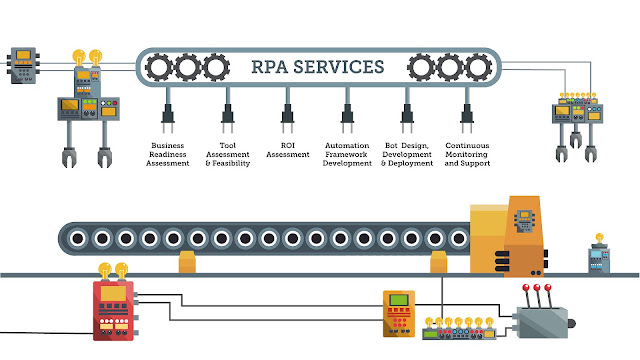Drawbacks in Automation Projects and Best Ways to avoid them
RPA has been adapted in several business organizations today to increase productivity, reduce time consumption, limit errors, and amplify the success of the organization.
Its obvious automation has both its positives and negatives. Although its positives far-outweigh the negative it is always best to avoid any repercussions and prepare for any eventuality if the drawbacks come up. That’s why companies using automation have to ensure adequate research about the services their automation offers along with its pros and cons.
Automation
Going by Automation Anywhere Services USA, automation is the process of combining minimum human interference with technology- aided mechanisms. This includes work gadgets that smoothly run without mundane effort. These equipment include among others: machinery, apparatus and many other software-controlled devices. The basic aim of automation is to ease or lessen human effort, reduce errors and maximize efficiency and productivity.
Types of Automation
Fixed Automation
Programmable Automation
Flexible Automation
Fixed Automation
It is characterized by both elevated production rate and investment. It can also be referred to as hard Automation.
Programmable Automation
This type of automation is characterized by its ability to produce products in batches. All the products needed to be produced are categorically arranged and produced in batches. The productivity rate is generally low as compared to the other types of automation.
Flexible Automation
It is an advanced version of programmable automation as it mixes various products for production and does not take as much time as programmable automation does.
Automation Tools
Artificial Neural Network.
Human Machine Interface.
Instrumentation.
Robotics.
Host Simulation Software.
Robotic Process Automation [Robotics]
It is the advanced step every organization has to take in the evolution of its business. The beauty of RPA does not only reflect in a decreased number of employees but also increased the volume of production. It grants the employees the opportunity to focus on more relevant tasks as well as to improve their skills.
Drawbacks in Automation Projects and the Best Ways to avert them.
1. Anxiety or Fear of Unemployment
As technology advances, it's and uses adaptabilities increase. This makes several employees to constantly live in fear of losing their jobs at any time which is a present-day reality.
However, most business setups aim to achieve proficiency. That's why they have adopted the latest automation tools. The tools can readily perform the same tasks in shorter times and with more efficiency.
As automation levels increase, the levels of anxiety or fear of unemployment in some employees are also peaking. This doesn’t have to be a negative drawback, since automation frees employees from long, repetitive and monotonous works. Progressive employers can set up training courses for their employees to enhance their skills and provide them with opportunities to work in more enthusiastic tasks.
2. Initial High Capital Cost
It is true that automation increases productivity and increase ROI as well. But the initial expenditure required to set it up is usually high and that is why it is important to make the decision while considering investments and what you hope to achieve.
3. Redundant Customized Automation
When it comes to production, the company makes use of certain automated tools and machinery which indeed perform the needed actions and carry out the tasks efficiently. But in a situation whereby the demand of the company has changed or the production process has evolved such tools or machinery can instantly become dormant. Thus, it is important for every automated company to ensure that it uses only such automated systems designed to function across every task and adapt to changes.
4. Long Term Capital Maintenance
There is no doubt that automation enhances productivity and increases ROI. However, expenditure and maintenance costs not only to set up but also to ensure keeping high standards of running require total commitment to deciding while thinking of long-term capital investments.
5. Unpredictable Expenditure
Although automation saves cost it can also bring about unexpected expenses than it has saved. It can incur spending in research, development, costs in training employees and much more thus it is important for the company to constantly maintain the automated services it uses.
6. High Cost of Maintenance
To promote efficiency and productivity, it’s essential for the company to constantly take care of the services it has implored. Maintenance of automated services most often cost much expenditure when it is required.
7. Lower Overall Purchasing Power
Competition in the business market compels several companies to use automated processes in their service delivery. However, though their overall production rate increases, the purchasing power is declining. This is attributed to the high numbers of unemployed caused by automation. With several unpaid workers in the population, it cripples or impacts overall purchasing power.
Therefore, it's best for companies to mix both automation ad employees. The companies can provide new job options and employees should constantly develop and improve their skill sets.
8. Limitations in Technology
It's true presently, technology cannot perform all the desired tasks a company might aspire to accomplish. On the other hand, employees can adapt to multiple situations. That is why it is vital to incorporate both human and technology interaction in the workplace.
9. Financial Obstacles
Automation is best appreciated when it performs repetitive, tedious and larger tasks that are hard for human sustenance. It not only helps save time, enhance accuracy and productivity and save cost. It would require the hiring of hundreds of staff to perform simple tasks even when the business has limited funds.
10. High Costs of Upgrades and Updates
Updating automated services requires a substantial budget and expenditure outlay. It constantly requires ensuring all expired tools are replaced as they slow down the work rate, overall production and leads to increased errors. It's vital for the company to ensure regular budget outlay dedicated to updates and upgrades in their automated services.
Summary
For RPA Services USA, it’s true that automation promotes business booms by increasing productivity, elevates profit rates, reduces errors, decreases human efforts, reduces time consumption and is readily available on demand. It is also true that it rids several employees of their livelihood, renders some skills obsolete, creates an imbalance in the economy, and decreases the purchasing power of the population among its many other drawbacks. However, it is equally vital for automated companies to ensure that there is a balance between the advantages and drawbacks automation projects can present.



Comments
Post a Comment